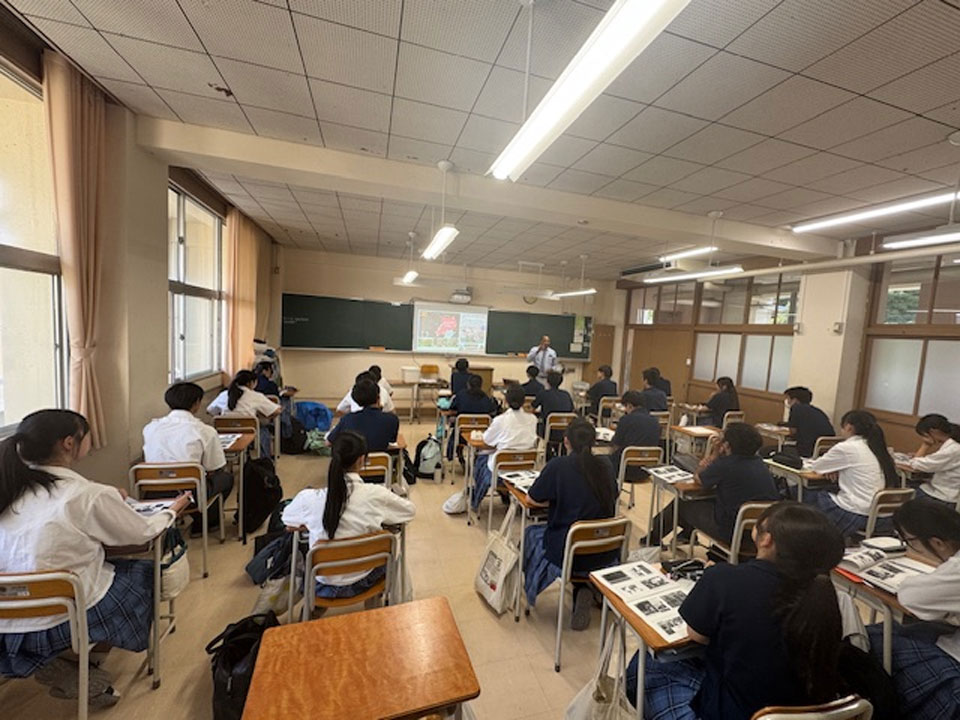Empowering the Next Generation through STEAM – “Tankyu” to Explore Innovation and Global Collaboration at Sasayama Hōmei High School
11-21-2025
Background
I’m Emmanuel Ninsiima, a JICA Scholar and intern at Scaleout Inc., and I am honored to share my experience giving a lecture at Sasayama Hōmei High School in Hyogo Prefecture, Japan.

The students there are currently engaged in STEAM (Science, Technology, Engineering, Arts, and Mathematics) education, a program that encourages them to connect those five areas to solve real-world problems.
JICA Kansai carries out a school visit program “Demae Koza”, that promotes global understanding among Japanese students. This initiative connects learners with professionals from around the world, helping them discover how innovation can make a positive impact on society.
I was grateful to take part in this program as part of my internship at Scaleout Inc., which supports international collaboration through innovation.
What Is STEAM Education?
In a world that is changing faster than ever, education must evolve to prepare students not only with knowledge but also with creativity, adaptability, and innovation. STEAM education integrates Science, Technology, Engineering, Arts, and Mathematics representing a new way of learning that encourages students to think critically, solve real-world problems, and connect academic theory with practical applications.
STEAM combines technical and creative disciplines that build well-rounded thinkers. Science develops curiosity and a spirit of inquiry. Technology provides tools for innovation. Engineering teaches design and problem-solving. Arts foster creativity and empathy, while Mathematics strengthens logic and precision. By connecting these areas, students learn how to apply knowledge to meaningful challenges preparing them to lead in the 21st century.
Fourth Industrial Revolution (4IR)
The world is now living through the Fourth Industrial Revolution (4IR), a transformation that connects digital, physical, and biological systems. It covers wide-ranging fields such as Artificial Intelligence (AI), Big Data, Blockchain Technologies, Robotics, Internet of Things (IoT), Cloud Computing, Nanotechnology, Biotechnology, Genetic Engineering, Quantum Computing, Autonomous Vehicles, and 3D/4D Printing. These emerging technologies are reshaping industries and creating new opportunities.
For students, understanding 4IR helps bridge the gap between classroom learning and future careers in science, engineering, and creative innovation.
Society 5.0
I also introduced Society 5.0 concept. It builds upon the Fourth Industrial Revolution to create a “super smart society” where technology enhances human life. According to the Cabinet Office of Japan, Society 5.0 is “a society that is sustainable and resilient against threats and unpredictable and uncertain situations, that ensures the safety and security of the people, and that enables individuals to realize diverse well-being.” Society 5.0 provides a vision for addressing Japan’s social challenges from an aging population to environmental sustainability and economic inequality through innovation, inclusion, and empathy.
Developing 21st Century Skills
Through STEAM activities and exposure to 4IR and Society 5.0 concepts, students learned about the 21st Century Skills needed to succeed in a rapidly changing world. These skills go beyond traditional academic knowledge and include Critical Thinking, Collaboration, Communication, and Creativity. These competencies empower students to navigate the modern world with confidence, curiosity, and compassion.
Students were also encouraged to design and carry out projects that connect STEAM principles with real-world challenges. They explored the main phases of project management: conception and initiation, planning, execution, monitoring and controlling, and closure. Through this process, students can apply knowledge, teamwork, and creativity to address community issues from environmental awareness to social innovation.
Sharing Experiences and Perspectives
During my visit, I shared insights into digital transformation, sustainability, and innovation, emphasizing how technologies such as blockchain and artificial intelligence can contribute to social good. We discussed how Japan and other countries can apply innovation to address social and environmental issues through collaboration and empathy.
The kind of class can be platform for mutual learning. The students can share creative ideas about using technology for positive change, particularly in areas like community development. Their conscientiousness showed how STEAM education cultivates not only technical knowledge but also global awareness and a sense of shared responsibility.
Conclusion and Appreciation
In conclusion, students learned how to identify personal and community challenges, generate ideas, and develop effective, sustainable solutions. Although some found expressing feedback in English slightly challenging, their sincere attitude reflected a genuine global learning spirit.
Special thanks go to JICA Kansai, especially Ms. Kaori Tsuda and Ms. Aya Hashimoto, for the opportunity to speak to the STEAM high school students. Appreciation also goes to entire Sasayama Hōmei High School Leadership, Teachers, for their support and encouragement throughout this inspiring experience.
Together, this initiative highlighted how Japan’s youth can shape a smarter, more sustainable, and compassionate society through STEAM, 4IR, and the values of Society 5.0.
Lectured and written by: Emmanuel Ninsiima
Support: Hiroshi Oggy Ogino, Daniel Ruyonga
Scaleout Inc.
